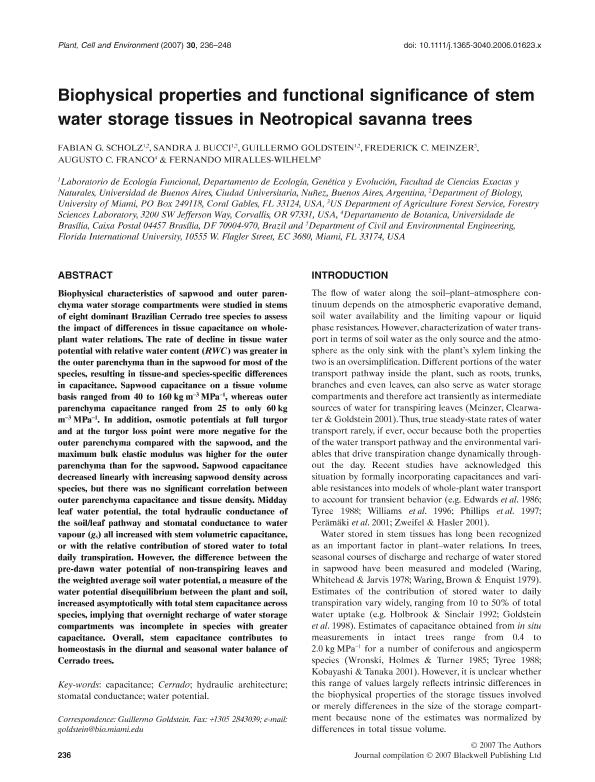Mostrar el registro sencillo del ítem
dc.contributor.author
Scholz, Fabian Gustavo

dc.contributor.author
Bucci, Sandra Janet

dc.contributor.author
Goldstein, Guillermo Hernan

dc.contributor.author
Meinzer, Frederick
dc.contributor.author
Franco, Augusto
dc.contributor.author
Miralles Wilhem, Fernando
dc.date.available
2020-03-30T14:33:58Z
dc.date.issued
2007-12
dc.identifier.citation
Scholz, Fabian Gustavo; Bucci, Sandra Janet; Goldstein, Guillermo Hernan; Meinzer, Frederick; Franco, Augusto; et al.; Biophysical properties and functional significance of stem water storage tissues in Neotropical savanna trees; Wiley Blackwell Publishing, Inc; Plant, Cell and Environment; 30; 2; 12-2007; 236-248
dc.identifier.issn
0140-7791
dc.identifier.uri
http://hdl.handle.net/11336/101271
dc.description.abstract
Biophysical characteristics of sapwood and outer parenchyma water storage compartments were studied in stems of eight dominant Brazilian Cerrado tree species to assess the impact of differences in tissue capacitance on whole-plant water relations. The rate of decline in tissue water potential with relative water content was greater in the outer parenchyma than in the sapwood for most of the species, resulting in tissue-and species-specific differences in capacitance. Sapwood capacitance on a tissue volume basis ranged from 40 to 160 kg m-3 MPa-1, whereas outer parenchyma capacitance ranged from 25 to only 60 kg m-3 MPa-1. In addition, osmotic potentials at full turgor and at the turgor loss point were more negative for the outer parenchyma compared to the sapwood, and the maximum bulk elastic modulus was higher for the outer parenchyma than for the sapwood. Sapwood capacitance decreased linearly with increasing sapwood density across species, but there was no significant correlation between outer parenchyma capacitance and tissue density. Midday leaf water potential, the total hydraulic conductance of the soil/leaf pathway and stomatal conductance all increased with stem volumetric capacitance, or with the relative contribution of stored water to total daily transpiration. However, the difference between the predawn water potential of non-transpiring leaves and the weighted average soil water potential, a measure of the water potential disequilibrium between the plant and soil, increased asymptotically with total stem capacitance across species, implying that overnight recharge of water storage compartments was incomplete in species with greater capacitance. Overall, stem capacitance contributes to homeostasis in the diurnal and seasonal water balance of Cerrado trees.
dc.format
application/pdf
dc.language.iso
eng
dc.publisher
Wiley Blackwell Publishing, Inc

dc.rights
info:eu-repo/semantics/openAccess
dc.rights.uri
https://creativecommons.org/licenses/by-nc-sa/2.5/ar/
dc.subject
Capacitance
dc.subject
Cerrado
dc.subject
Hydraulic architecture
dc.subject
Stomatal conductance
dc.subject
Water potential
dc.subject.classification
Ecología

dc.subject.classification
Ciencias Biológicas

dc.subject.classification
CIENCIAS NATURALES Y EXACTAS

dc.title
Biophysical properties and functional significance of stem water storage tissues in Neotropical savanna trees
dc.type
info:eu-repo/semantics/article
dc.type
info:ar-repo/semantics/artículo
dc.type
info:eu-repo/semantics/publishedVersion
dc.date.updated
2020-03-16T14:59:41Z
dc.journal.volume
30
dc.journal.number
2
dc.journal.pagination
236-248
dc.journal.pais
Reino Unido

dc.journal.ciudad
Hoboken
dc.description.fil
Fil: Scholz, Fabian Gustavo. Universidad de Buenos Aires. Facultad de Ciencias Exactas y Naturales. Departamento de Ecología, Genética y Evolución; Argentina. University of Miami; Estados Unidos. Consejo Nacional de Investigaciones Científicas y Técnicas; Argentina
dc.description.fil
Fil: Bucci, Sandra Janet. Universidad Nacional de la Patagonia "San Juan Bosco". Instituto de Biociencias de la Patagonia. Consejo Nacional de Investigaciones Científicas y Técnicas. Centro Científico Tecnológico Conicet - Centro Nacional Patagónico. Instituto de Biociencias de la Patagonia; Argentina
dc.description.fil
Fil: Goldstein, Guillermo Hernan. Consejo Nacional de Investigaciones Científicas y Técnicas. Oficina de Coordinación Administrativa Ciudad Universitaria. Instituto de Ecología, Genética y Evolución de Buenos Aires. Universidad de Buenos Aires. Facultad de Ciencias Exactas y Naturales. Instituto de Ecología, Genética y Evolución de Buenos Aires; Argentina
dc.description.fil
Fil: Meinzer, Frederick. Department of Agriculture Forest Service; Estados Unidos
dc.description.fil
Fil: Franco, Augusto. Universidade do Brasília; Brasil
dc.description.fil
Fil: Miralles Wilhem, Fernando. Florida International University; Estados Unidos
dc.journal.title
Plant, Cell and Environment

dc.relation.alternativeid
info:eu-repo/semantics/altIdentifier/doi/http://dx.doi.org/10.1111/j.1365-3040.2006.01623.x
dc.relation.alternativeid
info:eu-repo/semantics/altIdentifier/url/https://onlinelibrary.wiley.com/doi/full/10.1111/j.1365-3040.2006.01623.x
Archivos asociados
